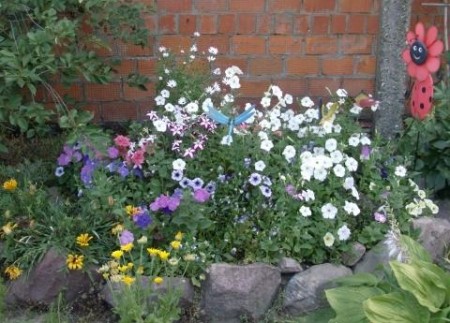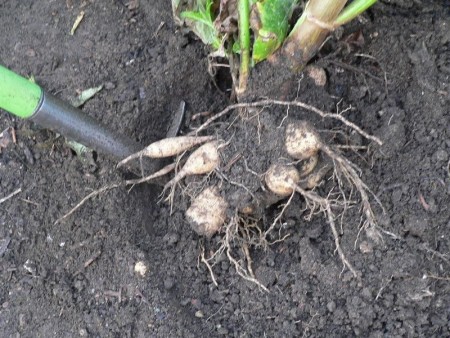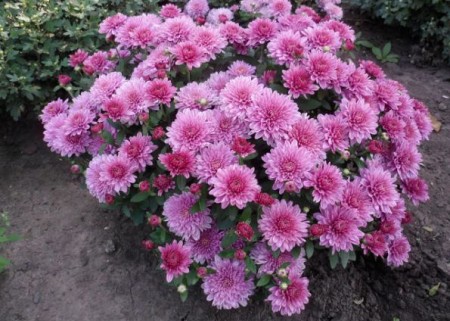Article from the section "Calendar of work for a gardener, gardener, florist."
Many plants have perked up after the summer. If we cut off the faded inflorescences and sun-dried leaves, the perennials now look bright and juicy.
Tall sedums and perennial asters continue to bloom; pansies, tagetes, petunias, zinnias, snapdragons, and delphiniums have seen their “second” wind.
Dahlias “scream” about their beauty.Cold nights continue to add brightness to ornamental cabbage, which may soon remain the only bright spot in a falling asleep garden.
What flower growers need to do in October
Your flower garden: work of the month.
But before parting with your favorite plants, there is time to complete the most urgent work.
We must hurry with dividing and replanting perennials. The later we do this, the less time the plants will have to take root and safely overwinter in a new place.
Planting bulbous plants
You also need to hurry up with planting small-bulbous daffodils: they are planted earlier than tulips, the planting time of which comes in the second half of October.
Small-bulbous plants are usually planted in such a way that they are not dug up for several years and are given the opportunity to grow into spectacular clumps. Many summer residents also leave tulips, daffodils, and hyacinths in one place for a single year.
This must be taken into account when determining the distance between the bulbs when planting. The bulbs, which are dug up annually, are placed from each other at a distance equal to 1-2 bulb diameters. Bulbs that will not be dug up for 2-3 years are planted more rarely.
We choose areas for bulbous plants that are free from weeds and have fertile, air- and moisture-permeable soil. Moreover, the structure of the soil is more important for them than fertility.
The soil in which we plant tulips, crocuses and others must be moist, because the bulbs need to take root before the onset of frosty weather.
Flower growers very often in the fall cannot find a use for all the dug up bulbs and onions. There are often a lot of extra muscari, crocuses, tulips: the neighbors have already given them all away, and there is no free space left on their plot.
“Extra” bulbs, choosing the largest ones, can be planted in a container with a nutritious soil mixture in order to have flowering plants in the room early in the spring. For forcing crocuses and muscari, shallow wide bowls are suitable, in which the bulbs are planted close to each other.
The containers are placed in a cool place (+ 6 +10 degrees) for rooting. Before the onset of frosty weather, containers with planted bulbs can be buried in the garden and later lowered into the basement.
We are in a hurry to get ahead of the frosts
In October we dig up plants that do not overwinter in open ground. Before cleaning, dry the gladioli corms in a warm room at a temperature of 25 degrees and above. If they were dug up in rainy weather, it will take a month or longer to dry. After this, we sort the corms and reject the diseased ones.
We dig up the dahlia tuber roots before the onset of heavy frost. Before digging, we cut off the stems, leaving stumps 10-15 cm high. We clear the dug nests of soil, wash them, disinfect them for 10-15 minutes in a dark pink solution of potassium permanganate, shorten the stems to 7-10 cm. Dry the tuber roots in a cool room for 1-2 days indoors. Store covered with dry sand or sawdust at a temperature of +3 +5 degrees.
Read when to dig up and how to store dahlia tubers Here
After frost, we dig up the begonia tubers and, without clearing them from the ground, dry them for several days at a temperature of 15-20 degrees. The soil from the tubers should not crumble! Then we place the tubers in one layer in a box and cover them with sand. Store at low temperatures above zero, moistening the sand if necessary.
Before the onset of frost, we dig up the cannas, trying to keep a clod of earth on the rhizomes, cut off the stems, leaving stumps of 15-20 cm. We store them in the basement.
Cool summers and rainy autumns contribute to the development of fungal diseases, so in such weather, autumn treatment of plants with 1% Bordeaux mixture or abiga-pik is relevant.
After pruning, roses can be sprayed with a solution of copper (100 g) or iron sulfate (300 g per 10 liters of water). Leaves and cut stems, if they are affected by powdery mildew or rust, are burned.
Let's think about how to provide roses with a dry winter, because in humid conditions under cover, diseases will continue to develop, and in the spring you may miss your favorite plants.
It is advisable to treat peonies and phlox after pruning. We will not use the cut leaves to cover the base of the bushes for the winter, but will put them in the compost heap. Mulch the root area with compost. Before this, the soil can be sprinkled with wood ash: both a good winter fertilizing and disinfection.
Let's take care of chrysanthemums
We will take care of the safety of Korean chrysanthemums, which do not survive safely every winter. After flowering, we dig up small bushes, trim them, transplant them into pots and store them in a cold basement, periodically moistening the soil moderately so as not to dry out the roots.
In February-March we will bring the chrysanthemums into a warm room and, after allowing them to grow, we will cut them. If this option does not suit you, you can simply take 2-3 cuttings from each variety and root them in boxes or pots at home, and plant the young plants in the ground in the spring.
We will have a “reserve”, and in the event of an unsuccessful overwintering of chrysanthemums in the garden, we will not lose our favorite varieties.
We are preparing areas for winter sowing of cold-resistant summer crops. We dig up the vacant areas. When digging, add compost, humus, 2-3 tbsp. spoons of superphosphate, 1-1.5 tablespoons of potassium sulfate per sq. m.
For those who have not yet had to cut chrysanthemums, it will be useful to read the article “Propagation of chrysanthemums by cuttings”, in which the entire cutting process is described in great detail.
Let's start pruning perennials
In October there is a lot of work not only for the shovel, but also for the pruning shears. We prune herbaceous perennial bushes that have faded and lost their decorative appearance.
For clematis that bloom on the shoots of the current year, we cut the shoots down to the ground; and for those blooming on last year’s shoots, we shorten them by a third or cut out only the immature part.
It is described in great detail about working with clematis in the fall. Here
We shorten rose branches to mature wood. Low dense bushes, for example, perennial asters, and cereal grasses can be left unpruned even after flowering.
Plants sprinkled with frost and snow will decorate the garden in late autumn and winter.
There is still time to collect annual seeds. We choose a dry, sunny day for this important activity. Seeds collected in rainy weather do not have good germination. Immediately lay out the collected wealth to dry.
In October we bring indoor flowers into the house
We bring in the last plants from the garden, from the balcony, wash them from dust, and spray them with phytoverm to prevent the appearance of pests.
Plants that require cold wintering (fuchsia, hydrangea, etc.), if possible, are left on the veranda or glassed-in loggia, where the temperature in winter does not drop below + 3 + 6 degrees. We water such plants rarely and so that only the roots do not dry out.
In the room we reduce watering, lower the temperature for hippeastrums and succulents.
We remove wilted, yellowed leaves from Saintpaulias, add soil to the bare stems or replant the plants.
We continue to water with warm water and feed flowering bells, begonias, and eucharis with weak solutions of mineral fertilizers.
After the start of the heating season, we take care that the plants do not suffer from dry air: we spray them, place containers with flowers on wide pallets with wet expanded clay.





 (5 ratings, average: 4,40 out of 5)
(5 ratings, average: 4,40 out of 5) CUCUMBERS NEVER GET SICK, I'VE BEEN USING ONLY THIS FOR 40 YEARS! I SHARE A SECRET WITH YOU, CUCUMBERS ARE LIKE THE PICTURE!
CUCUMBERS NEVER GET SICK, I'VE BEEN USING ONLY THIS FOR 40 YEARS! I SHARE A SECRET WITH YOU, CUCUMBERS ARE LIKE THE PICTURE! You can dig a bucket of potatoes from each bush. Do you think these are fairy tales? Watch the video
You can dig a bucket of potatoes from each bush. Do you think these are fairy tales? Watch the video
 How our fellow gardeners work in Korea. There is a lot to learn and just fun to watch.
How our fellow gardeners work in Korea. There is a lot to learn and just fun to watch. Eye trainer. The author claims that with daily viewing, vision is restored. They don't charge money for views.
Eye trainer. The author claims that with daily viewing, vision is restored. They don't charge money for views. A 3-ingredient cake recipe in 30 minutes is better than Napoleon. Simple and very tasty.
A 3-ingredient cake recipe in 30 minutes is better than Napoleon. Simple and very tasty. Therapeutic exercises for cervical osteochondrosis. A complete set of exercises.
Therapeutic exercises for cervical osteochondrosis. A complete set of exercises. Which indoor plants match your zodiac sign?
Which indoor plants match your zodiac sign? What about them? Excursion to German dachas.
What about them? Excursion to German dachas.